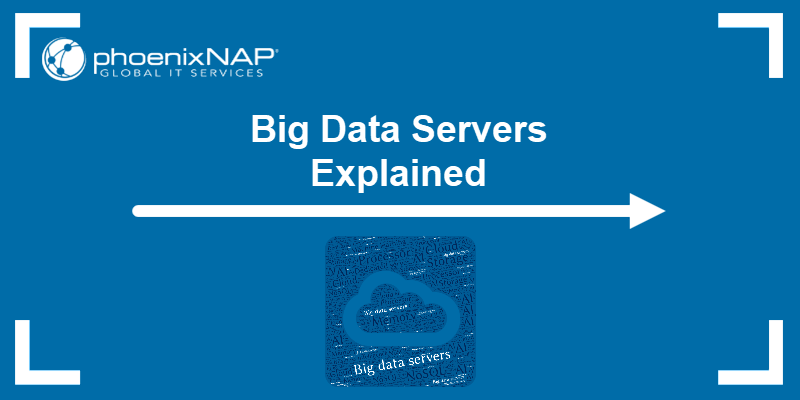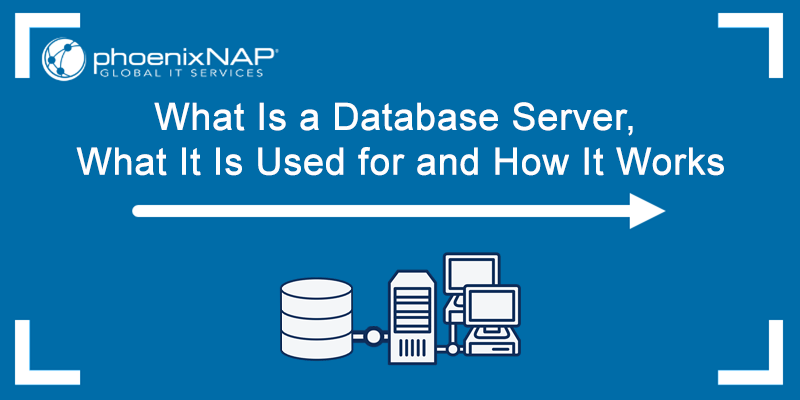Introduction
Server operating systems are designed for platforms that act as web servers, application servers, database servers, email servers, or other platforms running on a dedicated server.
Server operating systems offer various benefits compared to standard operating systems, including unlimited user connections, more memory, and advanced network optimizations.
In this article, you will learn about different server operating systems and how to choose the best server OS for your needs.
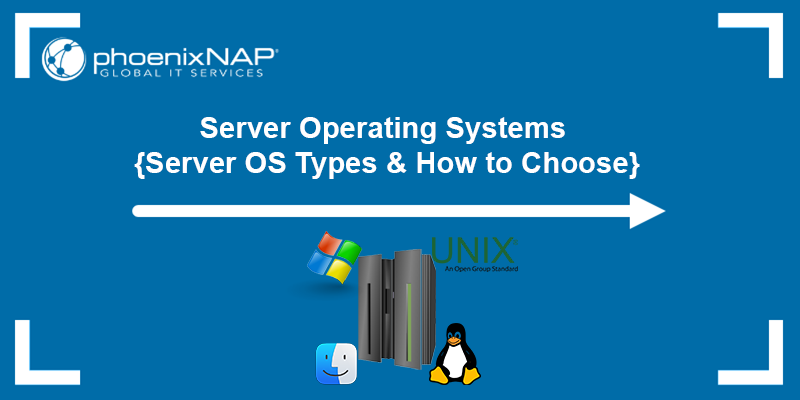
What is a Server Operating System
A server operating system is an advanced operating system designed to run on servers. It has the necessary features and subsystems to operate in a client-server architecture and serve clients' requests.
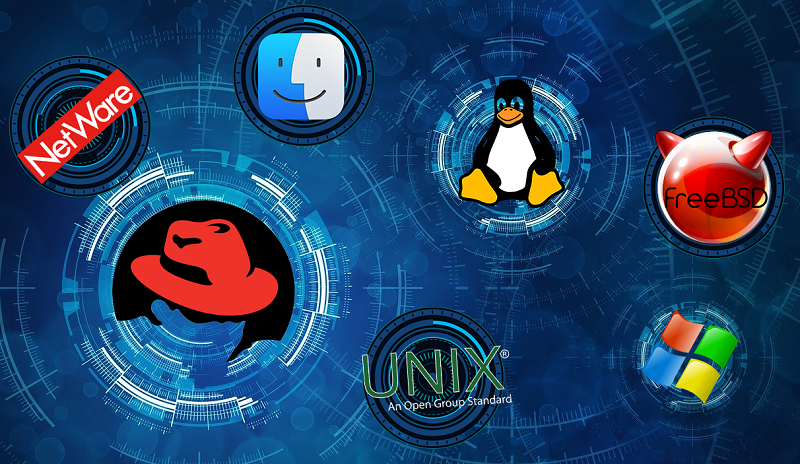
A server OS is designed from the ground up to provide features suitable for multi-user, business-critical applications. It provides the central interface for managing users, implementing security, and other administrative processes. The focus of a server operating system is usually security, stability, and cooperation.
Note: To ensure maximum performance and stability for any workload, combine an OS of your choice with our Bare Metal Cloud servers. Choose from 20 preconfigured instances, select your desired OS, and deploy in a few clicks. Ubuntu instances boot up in less than 120 seconds!
Server operating systems facilitate the implementation of various server platforms, such as:
- Web servers. A web server hosts programs and data, and responds to client requests for web pages or other web-based services. Common web servers are Apache, Microsoft Internet Information Services (IIS), and Nginx.
- Mail servers. A mail server allows users to forward and receive emails for and from their business and controls individual email accounts based on a specific domain.
- File servers. File sharing involves a joint storage point for a business to store documents or data - a network drive.
- Database servers. Some server operating systems include database integration, which facilitates dynamic web page building based on the database contents.
- Application servers. Server operating systems must be able to run business-critical applications, whether that's a self-hosted CRM or a SaaS. A server OS usually functions as a shared environment for various collaborative applications.
- Print servers. Another feature that server operating systems facilitate is print sharing, allowing multiple machines to use a single printer.
Note: Learn the difference between Apache and Nginx.
Server operating systems are capable of handling several of the features mentioned above if the tasks don't require too many resources. If many clients/users need to be served or the hosted applications require a lot of processing power, diversify the functions across multiple servers.
The following section lists and explains the most common server operating systems.
Note: An application server or a web server - what are the differences?
Common Server Operating Systems
There is an abundance of operating systems available today. According to some statistics, roughly 80% of all servers use some variation of Linux, while about 20% of servers use Windows.
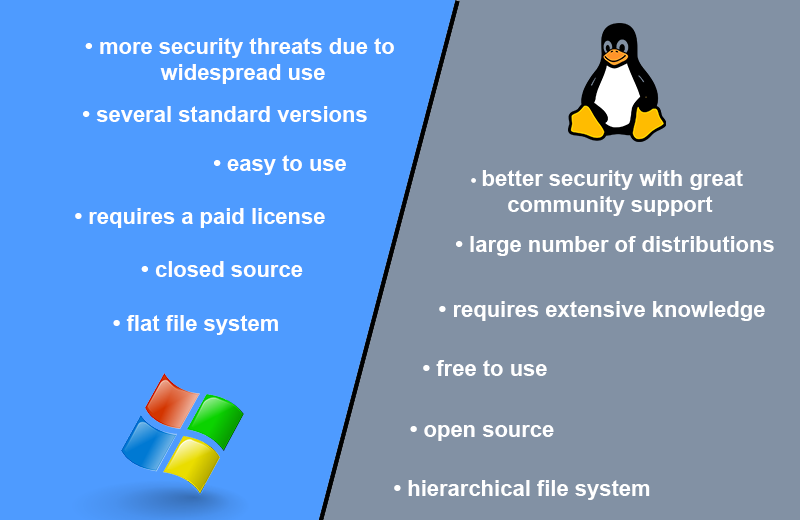
The stark difference in market share is likely because Linux is free and doesn't require user-based licensing like Windows.
Each OS has its pros and cons, and its ease of use depends on the user's technical competence level. The following list is not exhaustive, but it comprises the most common server operating systems.
1. Windows Server
Microsoft developed the Windows operating system family for everyday personal use and professional use in servers. The Windows Server OS supports enterprise-level management, data storage, and a vast array or applications.
Windows Server features virtual memory management, a complete desktop GUI experience, allows multitasking, and supports various peripheral devices. Microsoft usually provides 10 years of support for Windows Server.
The pros of a Windows server OS are the intuitive GUI, support for symmetric multi-processor systems, great third-party application support, and many versions to choose from. The cons are the need for user-based licensing and more virus security threats compared to other platforms.
2. Linux
Linux is a family of UNIX-like operating systems that have all the features of UNIX. It is open-source, available for free, facilitating multi-user, multi-process, multi-thread operations. However, Linux servers require more technical knowledge - from installation to maintenance and bug fixing.
One of the most common website hosting platforms, the LAMP stack, is based on Linux (Linux, Apache, MariaDB/MySQL, Perl/PHP/Python).
Note: LAMP vs. MEAN - see which software stack is better.
Some of the most popular Linux server distributions are:
- Ubuntu Server.
- Debian Server.
- Fedora.
- OpenSUSE Leap.
- SUSE Linux Enterprise Server.
- Arch Linux.
The pros of a Linux server OS are high security, a wide variety of distributions, integrated open-source software, including high-level language compilers, and the ability to control the system using a GUI.
The cons are the lack of long-term support for some distributions and certain complex operations, such as system updates.
3. Red Hat Enterprise Linux (RHEL)
RHEL is a paid Linux desktop and server distribution created by Red Hat. Initially, RHEL was released as the Red Hat Linux Advanced Server and later renamed Red Hat Enterprise Linux AS, which included two distributions - Red Hat Enterprise Linux ES and Red Hat Enterprise Linux WS.
The RHEL source code is freely available, but Red Hat uses strict regulations that limit its official Linux OS version redistribution. These limitations don't apply to third-party derivatives that don't include the non-free components, such as Red Hat's trademarks.
Note: In 2021, Red Hat has decided to make its RHEL OS free for small workloads.
The pros of RHEL are the extensive support and available patches, upgrades, and solutions for security vulnerabilities. The cons of RHEL are expensive training courses and the lack of personalized solutions.
4. UNIX-Based Operating Systems
In the beginning, UNIX was a time-sharing operating system for small computers, and over time it has become one of the most widespread client-server environment operating systems. The UNIX programming language is C, which facilitated the creation of UNIX ports for many machines.
The pros of UNIX are a multi-user environment, built-in TCP/IP support, and a high level of stability and security. The downside is that it is paid, and different vendors sell different UNIX versions, so there is no standard UNIX version.
5. NetWare
Novell NetWare is a server-based network operating system that requires a dedicated server to function. It was a widespread OS in early LANs.
Note: Learn the difference between a dedicated server and a cloud server.
The pros of NetWare are its support for multiprocessors and large-capacity physical memory management, as well as top-notch file sharing and printing functions in corporate networks. The OS also offers a wide range of management interfaces, including a Web interface.
The cons are the price, poor support, a challenging installation process, and low third-party app support.
6. macOS Server
The macOS Server is a UNIX-like server operating system based on macOS, developed by Apple. The OS builds on top of macOS and adds server functionality and system administration tools, as well as the tools to manage macOS and iOS devices.
The macOS Server is a great choice if you use Mac clients in your network, considering its ability to create features for Mac clients easily.
The macOS Server pros are easy administration, intuitive GUI, great support, and easy workload distribution across multiple machines. Thus, it is easy to increase the processing power. The OS comes with an unlimited user license.
The cons are that macOS Server only runs on Apple hardware, which can be pricey, and there aren't many third-party applications. Also, while Apple implements open-source software in its system, there are changes specific to macOS, requiring working around some issues not present in Linux.
7. FreeBSD
FreeBSD is a free and open-source Unix-like operating system. The OS maintains a complete system, delivering the kernel, drivers, utilities, and documentation, and includes an extensive server-related software collection. Thus, FreeBSD is easily configured as a mail server, web server, firewall, etc.
FreeBSD has its security team that inspects all the software shipped with the base distribution and allows the installation of third-party applications from binary packages.
The pros of FreeBSD are that it is fast, completely free, has good security that utilizes the ipfw firewall, and has a lot of tools available and owned by the FreeBSD Team.
The cons of FreeBSD are that it is not very easy to learn since it has poorer community support than Linux and lacks driver support.
Note: Learn how to build a server for your in-house needs.
Best Server OS for Businesses
This section explains which server operating systems best suit your organization based on its size. The list is not exhaustive, but it shows the best server OS choices.
Small
The best OS choice for a small business server depends on the budget, server type, and the maintenance team's expertise.
If you have a budget that can handle a server OS purchase, a good OS choice is the Windows Server Essentials (formerly Windows Small Business Server). It is a good solution for companies under 25 users and a small maintenance team.
The OS features a familiar interface and broad third-party app support at a reasonable price. It facilitates connectivity and includes email clients, remote access, support for mobile devices, file and printer sharing, backup and restore, and other features.
If you prefer a free and stable production OS, choose a free Linux distribution, such as Ubuntu Server or Debian.
Both Linux distributions are very popular and stable, featuring great community and official support. For example, Ubuntu's LTS (long-term support) releases receive updates for five years.
Note: CentOS is another great Linux distribution. However, official support for its latest version ended in December 2021, making it unusable for production environments.
Linux requires extensive knowledge, so make sure to have a knowledgeable system admin to handle configuration and the more complex operations.
Medium
For a medium-sized business, it's essential to choose an OS that allows your business to grow. However, you don't want heavy investments you may not need.
Because of their scalability, Linux distributions are possibly the best choice for a medium-sized business. An example is Ubuntu Server, a free, stable, easy-to-install OS with a trusted name. Since it is open-source, it features extensive customizability, allowing you to tailor the OS to your business needs.
Saving money on an OS means a bigger budget for scaling and implementing security features.
Other solutions that come with a price tag, but are cost-effective, are RHEL and Windows Server Standard Edition.
Large
Choosing an OS for a large business depends on the server type and its function. For example, a Windows Server in an Active Directory domain is a good choice for a file server, authentication server, or email server. On the other hand, both Windows and Linux are good choices for a web server.
For example, the Windows Server Datacenter Edition is a good choice for a highly virtualized datacenter or a cloud environment. The OS allows for an unlimited number of Windows server instances on a server, both in physical and virtual environments.
On the other hand, SUSE Linux Enterprise Server (SLES) is an open-source operating system. It is designed for extensive workloads in large data centers, but also for single-server environments. SLES is subscription-based and provides access to patches, fixes, and security updates through the SLES customer portal.
Conclusion
After reading this article, you should know more about the most common server operating systems and how to choose the best fit for your business.
If you still can't decide, read our blogs on Linux vs Windows servers and CentOS vs Ubuntu.

